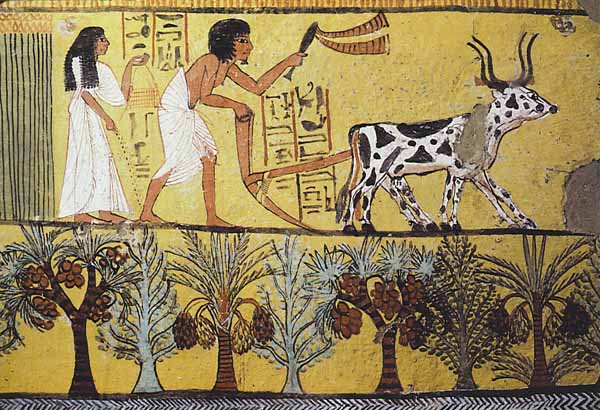

A combination of favorable geographical features contributed to the success of ancient Egyptian culture, the most important of which was the rich fertile soil resulting from annual inundations of the Nile River. The ancient Egyptians were thus able to produce an abundance of food, allowing the population to devote more time and resources to cultural, technological, and artistic pursuits. Land management was crucial in ancient Egypt because taxes were assessed based on the amount of land a person owned.
flooding season lasted from June to September, depositing on the river's banks a layer of mineral-rich silt ideal for growing crops. After the floodwaters had receded, the growing season lasted from October to February. Farmers plowed and planted seeds in the fields, which were irrigated with ditches and canals. Egypt received little rainfall, so farmers relied on the Nile to water their crops. From March to May, farmers used sickles to harvest their crops, which were then threshed with a flail to separate the straw from the grain. Winnowing removed the chaff from the grain, and the grain was then ground into flour, brewed to make beer, or stored for later use.
The ancient Egyptians cultivated emmer and barley, and several other cereal grains, all of which were used to make the two main food staples of bread and beer. Flax plants, uprooted before they started flowering, were grown for the fibers of their stems. These fibers were split along their length and spun into thread, which was used to weave sheets of linen and to make clothing. Papyrus growing on the banks of the Nile River was used to make paper. Vegetables and fruits were grown in garden plots, close to habitations and on higher ground, and had to be watered by hand. Vegetables included leeks, garlic, melons, squashes, pulses, lettuce, and other crops, in addition to grapes that were made into wine.
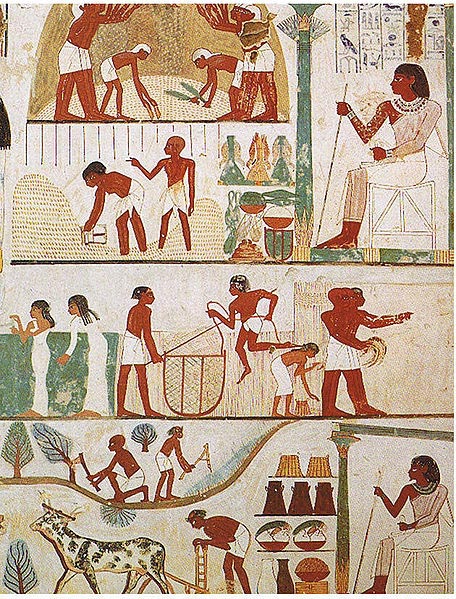
Egyptian society was highly stratified, and social status was expressly displayed. Farmers made up the bulk of the population, but agricultural produce was owned directly by the state, temple, or noble family that owned the land. Farmers were also subject to a labor tax and were required to work on irrigation or construction projects in a corvee system.
A combination of favorable geographical features contributed to the success of ancient Egyptian culture, the most important of which was the rich fertile soil resulting from annual inundations of the Nile River. The ancient Egyptians were thus able to produce an abundance of food, allowing the population to devote more time and resources to cultural, technological, and artistic pursuits. Land management was crucial in ancient Egypt because taxes were assessed based on the amount of land a person owned.
Farming in Egypt was dependent on the cycle of the Nile River. The Egyptians recognized three seasons: Akhet (flooding), Peret (planting), and Shemu (harvesting). The flooding season lasted from June to September, depositing on the river's banks a layer of mineral-rich silt ideal for growing crops. After the floodwaters had receded, the growing season lasted from October to February. Farmers plowed and planted seeds in the fields, which were irrigated with ditches and canals. Egypt received little rainfall, so farmers relied on the Nile to water their crops. From March to May, farmers used sickles to harvest their crops, which were then threshed with a flail to separate the straw from the grain. Winnowing removed the chaff from the grain, and the grain was then ground into flour, brewed to make beer, or stored for later use.
The ancient Egyptians cultivated emmer and barley, and several other cereal grains, all of which were used to make the two main food staples of bread and beer. Flax plants, uprooted before they started flowering, were grown for the fibers of their stems. These fibers were split along their length and spun into thread, which was used to weave sheets of linen and to make clothing. Papyrus growing on the banks of the Nile River was used to make paper. Vegetables and fruits were grown in garden plots, close to habitations and on higher ground, and had to be watered by hand. Vegetables included leeks, garlic, melons, squashes, pulses, lettuce, and other crops, in addition to grapes that were made into wine.
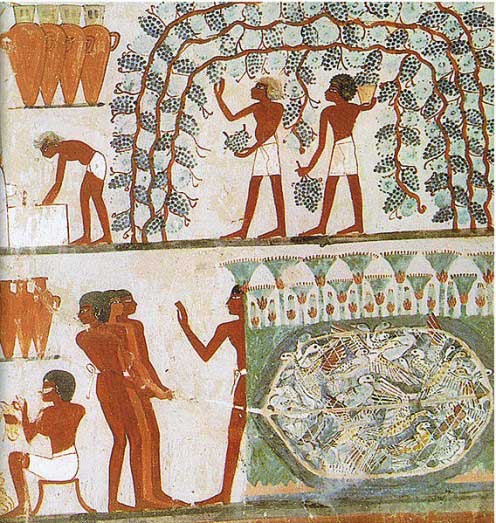
The Egyptians were very secure in that the Nile valley always yielded enough to feed the country, even when famine was present in other nearby parts of the world. The Egyptian's basic food and drink, bread and beer, were made from the main crops they grew, wheat and barely.
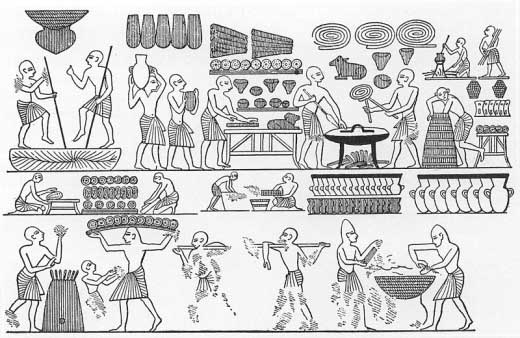
There were many types of bread, including pastries and cakes. Since there was no sugar, honey was used as a sweetener by the rich, and poor people used dates and fruit juices. Egyptians liked strong-tasting vegetables such as garlic and onions. They thought these were good for the health. They also ate peas and beans, lettuce, cucumbers, and leeks. Vegetables were often served with an oil and vinegar dressing.
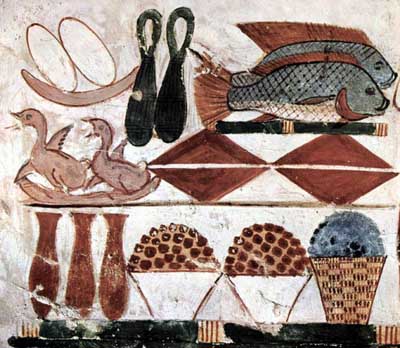
Figs, dates, pomegranates and grapes were the only fruits that could be grown in the hot climate. The rich could afford to make wine from their grapes. Ordinary people ate fish and poultry. On special occasions they ate sheep, goat, or pig; but there was little grazing land available so meat was expensive and most people ate it only on festive occasions. Egyptians stored their food in jars and granaries. Fish and meat had to be especially prepared for storage. One method was salting. Another was to hang up the fish in the sun, which baked them dry.
In ordinary families the cooking was done by the housewife, but larger households employed servants to work in the kitchen and a chef - usually a man - to do the cooking. The Egyptians had ovens, and knew how to boil roast, and fry food. There were few kitchen tools: pestles, mortars, and sieves.
Egyptian cuisine's history goes back to Ancient Egypt. Archaeological excavations have found that workers on the Great Pyramids of Giza were paid in bread, beer, and onions, apparently their customary diet as peasants in the Egyptian countryside. Dental analysis of occasional desiccated loaves found in tombs confirm this, in addition to indicating that ancient Egyptian bread was made with flour from emmer wheat. Though beer disappeared as a mainstay of Egyptian life following the Muslim conquest of Egypt in the year 641, onions remain the primary vegetable for flavoring and nutrition in Egyptian food. Beans were also a primary source of protein for the mass of the Egyptian populace, as they remain today.
Egyptian cuisine is notably conducive to vegetarian diets, as it relies heavily on vegetable dishes. Though food in Alexandria and the coast of Egypt tends to use a great deal of fish and other seafood, for the most part Egyptian cuisine is based on foods that grow out of the ground. Meat has been very expensive for most Egyptians throughout history, and a great deal of vegetarian dishes have developed to work around this economic reality.
What Did Ancient Egyptians Really Eat? Live Science - May 9, 2014
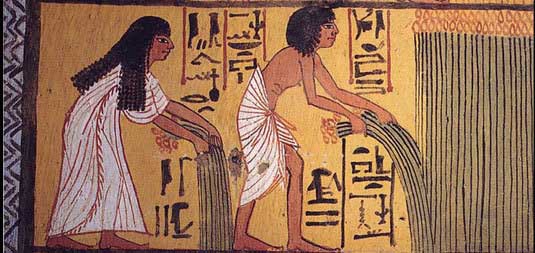 Did the ancient Egyptians eat like us? If you're a vegetarian, tucking in along the Nile thousands of years ago would have felt just like home. In fact, eating lots of meat is a recent phenomenon. In ancient cultures vegetarianism was much more common, except in nomadic populations. Most sedentary populations ate fruit and vegetables. Although previous sources found the ancient Egyptians to be pretty much vegetarians, until this new research it wasn't possible to find out the relative amounts of the different foods they ate. Was their daily bread really daily? Did they binge on eggplants and garlic? Why didn't someone spear a fish?
Did the ancient Egyptians eat like us? If you're a vegetarian, tucking in along the Nile thousands of years ago would have felt just like home. In fact, eating lots of meat is a recent phenomenon. In ancient cultures vegetarianism was much more common, except in nomadic populations. Most sedentary populations ate fruit and vegetables. Although previous sources found the ancient Egyptians to be pretty much vegetarians, until this new research it wasn't possible to find out the relative amounts of the different foods they ate. Was their daily bread really daily? Did they binge on eggplants and garlic? Why didn't someone spear a fish?
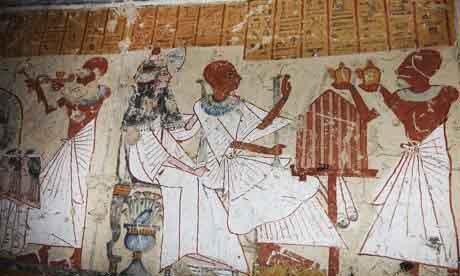
Archaeologists discover 3,000-year-old tomb of brewer to the gods in Egypt The Guardian - January 3, 2014
Scenes from ancient Egypt found on the walls of the newly discovered tomb in Luxor, which dates from about 3,000 years ago. Japanese archaeologists have unearthed the tomb of an ancient beer brewer in the city of Luxor that is more than 3,000 years old,
Egypt's minister of antiquities said. Mohammed Ibrahim said on Friday that the tomb dated back to the Ramesside period and belonged to the chief "maker of beer for gods of the dead", who was also the head of a warehouse. He added that the walls of the tomb's chambers contain "fabulous designs and colors, reflecting details of daily life along with their religious rituals". The head of the Japanese team, Jiro Kondo, says the tomb was discovered during work near another tomb belonging to a statesman under Amenhotep III, grandfather of the famed boy-pharaoh Tutankhamun.
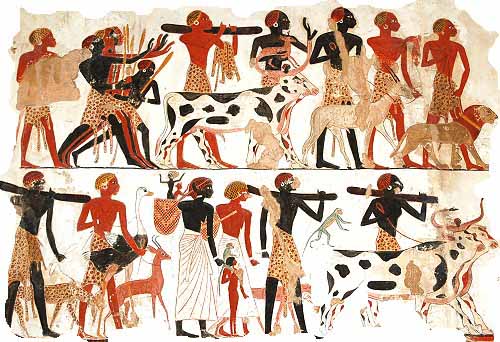
The Egyptians believed that a balanced relationship between people and animals was an essential element of the cosmic order; thus humans, animals and plants were believed to be members of a single whole. Animals, both domesticated and wild, were therefore a critical source of spirituality, companionship, and sustenance to the ancient Egyptians.
Cattle were the most important livestock; the administration collected taxes on livestock in regular censuses, and the size of a herd reflected the prestige and importance of the estate or temple that owned them. In addition to cattle, the ancient Egyptians kept sheep, goats, and pigs. Poultry such as ducks, geese, and pigeons were captured in nets and bred on farms, where they were force-fed with dough to fatten them. The Nile provided a plentiful source of fish. Bees were also domesticated from at least the Old Kingdom, and they provided both honey and wax.
The ancient Egyptians used donkeys and oxen as beasts of burden, and they were responsible for plowing the fields and trampling seed into the soil. The slaughter of a fattened ox was also a central part of an offering ritual. Horses were introduced by the Hyksos in the Second Intermediate Period, and the camel, although known from the New Kingdom, was not used as a beast of burden until the Late Period. There is also evidence to suggest that elephants were briefly utilized in the Late Period, but largely abandoned due to lack of grazing land.
Dogs, cats and monkeys were common family pets, while more exotic pets imported from the heart of Africa, such as lions, were reserved for royalty. Herodotus observed that the Egyptians were the only people to keep their animals with them in their houses. During the Predynastic and Late periods, the worship of the gods in their animal form was extremely popular, such as the cat goddess Bastet and the ibis god Thoth, and these animals were bred in large numbers on farms for the purpose of ritual sacrifice.
ANCIENT AND LOST CIVILIZATIONS